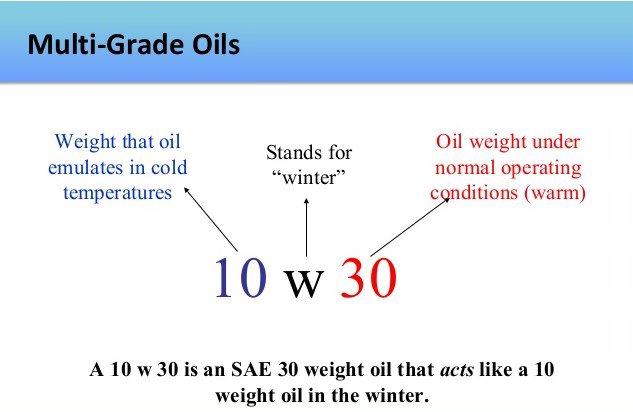考大家一个机油的基本常识,估计版上90%的不知道
版主: lexian
#1 考大家一个机油的基本常识,估计版上90%的不知道
5w30, 10w30, 5w20...
这些机油,是冷车的时候粘稠,还是热车的时候粘稠?
Update+correction:
机油的数字不是viscosity index,是grade,而且是高温或低温grade,所以没法体现跨温度的viscosity。5w代表该油的表现类似SAE5在低温的表现, 30代表该油的表现类似SAE30在高温的表现
还是wiki解释的清楚
所以是冷车的时候粘稠
这些机油,是冷车的时候粘稠,还是热车的时候粘稠?
Update+correction:
机油的数字不是viscosity index,是grade,而且是高温或低温grade,所以没法体现跨温度的viscosity。5w代表该油的表现类似SAE5在低温的表现, 30代表该油的表现类似SAE30在高温的表现
还是wiki解释的清楚
所以是冷车的时候粘稠
上次由 Savage 在 2024年 1月 23日 13:09 修改。
#8 Re: 考大家一个机油的基本常识,估计版上90%的不知道
奥托桑,不懂不要乱说,可以股沟
我的题目很清楚,同样的机油(比如5w30),冷的时候粘还是热的时候粘。你非要胡扯不同的标号互相比较,数字放在那里,有必要比吗?
5w就是低温粘度=5, 低粘度有利于启动。
30就是工作温度下粘度=30, 高粘度有利于保护发动机
你的明白?
#9 Re: 考大家一个机油的基本常识,估计版上90%的不知道
时代不同了,这种问题直接问chatgpt就好:
Engine oil ratings, often referred to as viscosity ratings or oil classifications, provide information about the oil's viscosity or thickness at different temperatures. These ratings help you choose the right oil for your vehicle's engine to ensure proper lubrication and protection.
The most common engine oil rating system is the SAE (Society of Automotive Engineers) viscosity rating, which consists of two numbers separated by a "W" (e.g., 10W-30). Here's what each part of the rating means:
The "W" stands for "winter." It indicates the oil's viscosity at low temperatures, specifically at 0 degrees Fahrenheit (-17.8 degrees Celsius) and is a measure of the oil's ability to flow in cold weather. The lower the "W" number, the better the oil flows in cold conditions. So, a 5W oil flows better in cold weather than a 10W oil.
The second number (e.g., 30 in 10W-30) represents the oil's viscosity at operating temperatures, usually around 212 degrees Fahrenheit (100 degrees Celsius). This number indicates the oil's thickness and resistance to flow when the engine is running hot. Higher numbers represent thicker oils, which provide better protection against wear under high-temperature conditions.
In general, you should choose the engine oil viscosity rating recommended by your vehicle's manufacturer. They specify the appropriate oil viscosity based on the engine's design and operating conditions. Using the right oil helps ensure proper lubrication and protection for your engine, contributing to its longevity and performance.
Additionally, you may come across other oil classifications like API (American Petroleum Institute) service categories (e.g., API SN, API CJ-4) that indicate the oil's performance and suitability for specific engines and applications. These classifications provide information about the oil's additives and its ability to meet certain performance standards and requirements. Always refer to your vehicle's owner's manual or consult with a mechanic to determine the correct engine oil rating and type for your specific vehicle.
Engine oil ratings, often referred to as viscosity ratings or oil classifications, provide information about the oil's viscosity or thickness at different temperatures. These ratings help you choose the right oil for your vehicle's engine to ensure proper lubrication and protection.
The most common engine oil rating system is the SAE (Society of Automotive Engineers) viscosity rating, which consists of two numbers separated by a "W" (e.g., 10W-30). Here's what each part of the rating means:
The "W" stands for "winter." It indicates the oil's viscosity at low temperatures, specifically at 0 degrees Fahrenheit (-17.8 degrees Celsius) and is a measure of the oil's ability to flow in cold weather. The lower the "W" number, the better the oil flows in cold conditions. So, a 5W oil flows better in cold weather than a 10W oil.
The second number (e.g., 30 in 10W-30) represents the oil's viscosity at operating temperatures, usually around 212 degrees Fahrenheit (100 degrees Celsius). This number indicates the oil's thickness and resistance to flow when the engine is running hot. Higher numbers represent thicker oils, which provide better protection against wear under high-temperature conditions.
In general, you should choose the engine oil viscosity rating recommended by your vehicle's manufacturer. They specify the appropriate oil viscosity based on the engine's design and operating conditions. Using the right oil helps ensure proper lubrication and protection for your engine, contributing to its longevity and performance.
Additionally, you may come across other oil classifications like API (American Petroleum Institute) service categories (e.g., API SN, API CJ-4) that indicate the oil's performance and suitability for specific engines and applications. These classifications provide information about the oil's additives and its ability to meet certain performance standards and requirements. Always refer to your vehicle's owner's manual or consult with a mechanic to determine the correct engine oil rating and type for your specific vehicle.
#10 Re: 考大家一个机油的基本常识,估计版上90%的不知道
你的意思是OIL温度越高越粘,越低越稀?你是文科生?Savage 写了: 2024年 1月 22日 20:05 奥托桑,不懂不要乱说,可以股沟
我的题目很清楚,同样的机油(比如5w30),冷的时候粘还是热的时候粘。你非要胡扯不同的标号互相比较,数字放在那里,有必要比吗?
5w就是低温粘度=5, 低粘度有利于启动。
30就是工作温度下粘度=30, 高粘度有利于保护发动机
你的明白?
#12 Re: 考大家一个机油的基本常识,估计版上90%的不知道
很显然这俩数字是不同的标准,油在低温更粘稠地球人都知道,Savage来自哪个星球不知道。
这个问题我以前是思考过的,但是没查到确切的解释,多谢你的info。
这个问题我以前是思考过的,但是没查到确切的解释,多谢你的info。
fantasist 写了: 2024年 1月 22日 20:16 时代不同了,这种问题直接问chatgpt就好:
Engine oil ratings, often referred to as viscosity ratings or oil classifications, provide information about the oil's viscosity or thickness at different temperatures. These ratings help you choose the right oil for your vehicle's engine to ensure proper lubrication and protection.
The most common engine oil rating system is the SAE (Society of Automotive Engineers) viscosity rating, which consists of two numbers separated by a "W" (e.g., 10W-30). Here's what each part of the rating means:
The "W" stands for "winter." It indicates the oil's viscosity at low temperatures, specifically at 0 degrees Fahrenheit (-17.8 degrees Celsius) and is a measure of the oil's ability to flow in cold weather. The lower the "W" number, the better the oil flows in cold conditions. So, a 5W oil flows better in cold weather than a 10W oil.
The second number (e.g., 30 in 10W-30) represents the oil's viscosity at operating temperatures, usually around 212 degrees Fahrenheit (100 degrees Celsius). This number indicates the oil's thickness and resistance to flow when the engine is running hot. Higher numbers represent thicker oils, which provide better protection against wear under high-temperature conditions.
In general, you should choose the engine oil viscosity rating recommended by your vehicle's manufacturer. They specify the appropriate oil viscosity based on the engine's design and operating conditions. Using the right oil helps ensure proper lubrication and protection for your engine, contributing to its longevity and performance.
Additionally, you may come across other oil classifications like API (American Petroleum Institute) service categories (e.g., API SN, API CJ-4) that indicate the oil's performance and suitability for specific engines and applications. These classifications provide information about the oil's additives and its ability to meet certain performance standards and requirements. Always refer to your vehicle's owner's manual or consult with a mechanic to determine the correct engine oil rating and type for your specific vehicle.
#14 Re: 考大家一个机油的基本常识,估计版上90%的不知道
我知道你脑子拧巴了,你可以把W之前的比较,5w比10w稀, w之后的比较,30比40稀。
但是不要把w之前的和之后的比较,我们地球人不那么干。
#15 Re: 考大家一个机油的基本常识,估计版上90%的不知道
“左冷右热, 当然是冷车粘稠,你有啥高论?” ---你的原话altopalo 写了: 2024年 1月 22日 20:25 我知道你脑子拧巴了,你可以把W之前的比较,5w比10w稀, w之后的比较,30比40稀。
但是不要把w之前的和之后的比较,我们地球人不那么干。
为什么不可以同一个油,不可以在不同温度下比较粘度?如果不可以,为什么要标出来?还要去测?
#16 Re: 考大家一个机油的基本常识,估计版上90%的不知道
Shell说的
A lubricant's viscosity will change with changes in temperature. As lubricants get hot, their viscosity drops; as they get cold, their viscosity increases. A viscosity index (VI) is assigned to a specific lubricant so that users have a clear understanding of the viscosity state at varying temperatures.
#17 Re: 考大家一个机油的基本常识,估计版上90%的不知道
对呀。altopalo 写了: 2024年 1月 22日 20:27 Shell说的
A lubricant's viscosity will change with changes in temperature. As lubricants get hot, their viscosity drops; as they get cold, their viscosity increases. A viscosity index (VI) is assigned to a specific lubricant so that users have a clear understanding of the viscosity state at varying temperatures.
5W=冷车viscosity, W means winter/cold, viscosity =5
30= 热车viscosity =30
数字越大,viscosity越高
5w30机油就是这样设计的,合成的.
你告诉我5w30在高温下更稀,我们都可以去起诉厂家索赔了。。。
#19 Re: 考大家一个机油的基本常识,估计版上90%的不知道
我知道答案了,Google bard回答了我的问题。油在低温的确是粘稠的,5w30,这种违反常识的数字是添加剂造成的。
I have question about engine oil grade, 5w30 oil, why the viscosity index is high at high temperature as 30 while viscosity index is low at low temperature as 5. I think oil visocity is lower when temperature is high
You are absolutely correct that in general, the viscosity of oil decreases (becomes thinner) as the temperature increases.
The behavior of the 5W-30 oil grade might seem counterintuitive because of the way multi-grade oils are designed and the way the viscosity index is used.
Key points to understand about 5W-30 oil:
"5W" - Low-Temperature Behavior: The "5W" part of the oil grade indicates the oil's viscosity at low temperatures (W stands for "winter"). A lower number (5W) means the oil is designed to flow more easily at cold startup to quickly lubricate engine components during colder weather.
"30" - High-Temperature Behavior: The "30" part represents the oil's viscosity at operating temperatures (when the engine is fully warmed up). This number signifies how well the oil maintains its thickness and protective film at high temperatures.
Viscosity Index and Additives: Multi-grade oils like 5W-30 use special additives called viscosity index improvers. These additives help the oil behave differently at different temperatures:
At low temperatures, these additives allow the oil to flow more readily (hence the lower "5" in 5W-30).
At high temperatures, the additives help the oil resist thinning too much, maintaining a protective layer between engine parts (this results in the higher "30" number).
In summary:
The viscosity of 5W-30 oil does indeed become thinner at high temperatures like any other oil.
However, due to the additives used, the rate at which it thins is controlled.
The Viscosity Index is a measure of how much the oil's viscosity changes with temperature. A higher Viscosity Index (like in 5W-30) means the oil is better at maintaining a more consistent viscosity across a wider temperature range.
#20 Re: 考大家一个机油的基本常识,估计版上90%的不知道
奥拓桑又又耍无赖了
我说的很清楚,5W30,重新调配以后的成品油,你非要把polyer添加剂分离出来证明你是对的。没了polyer,还是5w30不?就成了5W
x1




